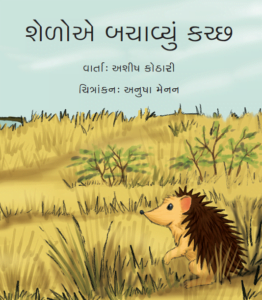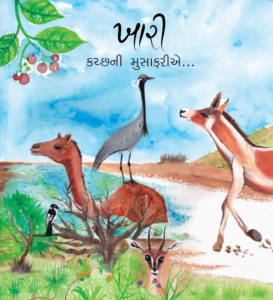Kalpavriksh has been involved in developing locale-specific environment education programmes for primary school children. What these programmes attempt to do is to link children’s learning to their immediate natural surroundings and to their social and cultural environments in meaningful ways. The overall objective is to inculcate a greater appreciation in children of their natural and cultural heritage in the hope that this would lead them to value, protect and conserve it.

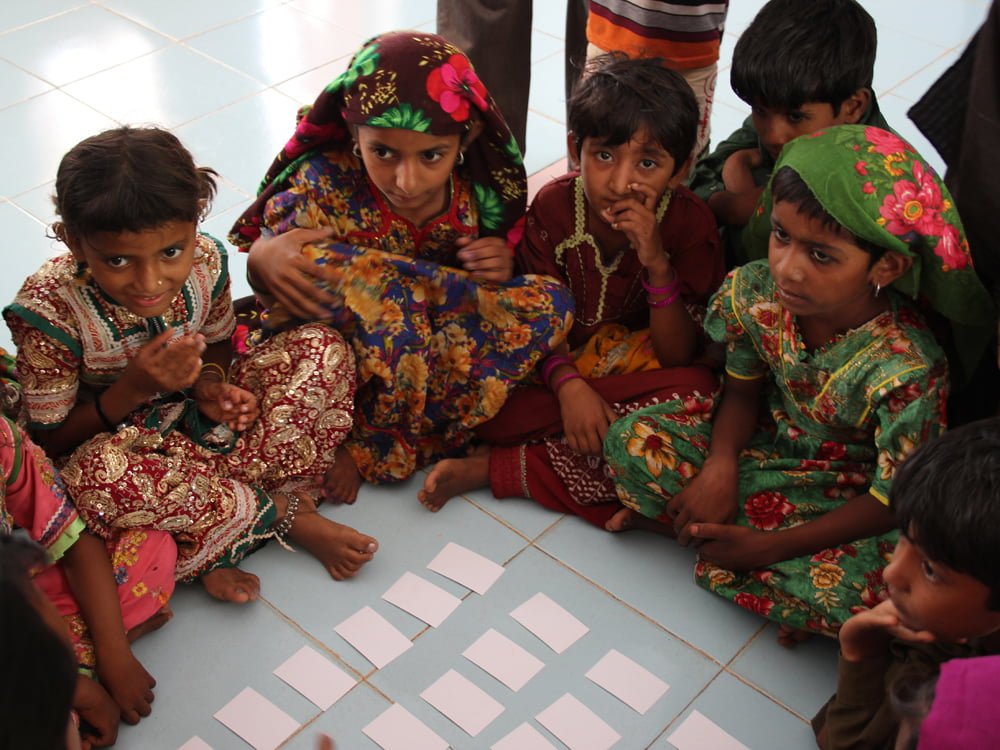
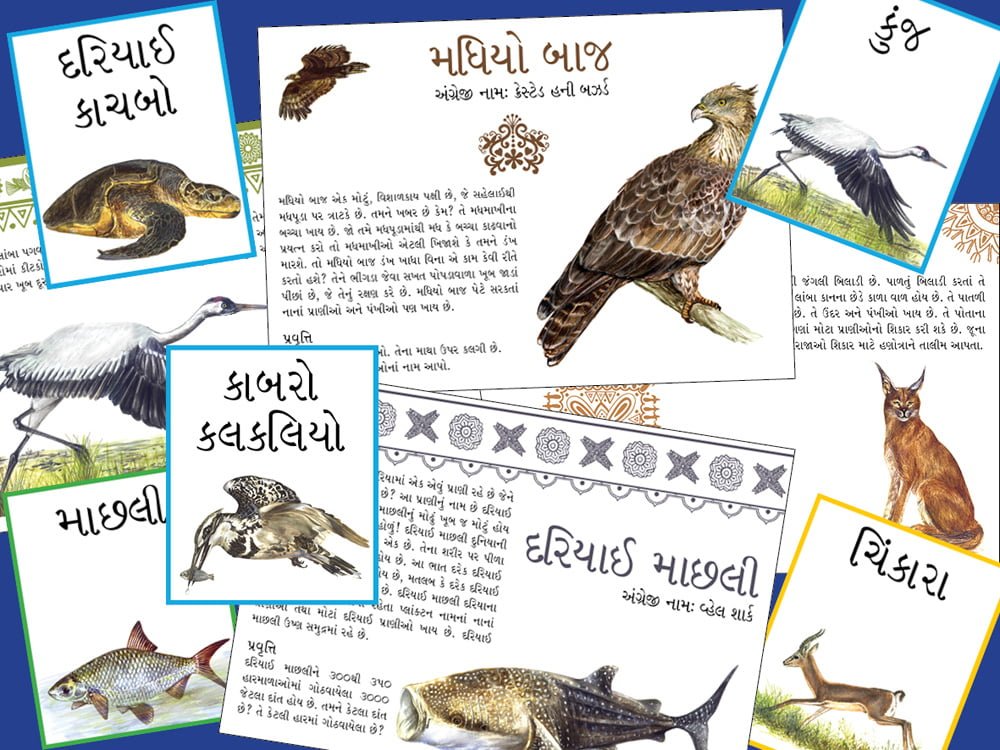
Kalpavriksh collaborated with NGOs in Kachchh (Sahjeevan and Kachchh NavNirman Abhiyan) to develop localised environmental education material for children in the district. This work was funded by Reach to Teach. Kalpavriksh produced two storybooks, ecosystem and wildlife posters, five games and a set of reading cards about local plants and animals. All materials were field tested. The storybooks (in Gujarati and English) are available for buying from our store.
Young Shero lives in Kutch, a beautiful place in Gujarat, in the West of India. One day she sees some strange people near her home. What are they doing there? When she discovers their plans, she panics. She rallies together many other animals living in the grasslands, wetlands and desert of Kachchh. What can they do to save their land, their homes?
This is a Gujarati storybook written by Ashish Kothari, translated by Rupa Majmudar and illustrated by Anusha Menon. The English version, Shero to the Rescue is available in our store.
Khari, a demoiselle crane on her first visit to Kachchh, journeys through the beautiful and diverse land, meeting many animals along the way.
This is a Gujarati storybook written by Sujatha Padmanabhan and Shruthi Ramakrishna of Khamir, the story has been translated into Gujarati by Rekha Bhimani and illustrated by Kalyani Ganapathy. The English version, Khaari journeys through Kachchh, is available in our store.
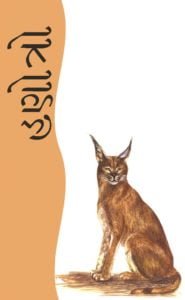 Apart from these two storybooks, Kalpavriksh produced ecosystem and wildlife posters, five games to familiarise children with Kachchh’s wild flora and fauna (Dominoes, Who eats what, Find a pair, Spot it and Fauna Bingo), and a set of 34 reading cards about local plants and animals, each containing simple information on a particular species as well as an activity that children can do.
Apart from these two storybooks, Kalpavriksh produced ecosystem and wildlife posters, five games to familiarise children with Kachchh’s wild flora and fauna (Dominoes, Who eats what, Find a pair, Spot it and Fauna Bingo), and a set of 34 reading cards about local plants and animals, each containing simple information on a particular species as well as an activity that children can do.
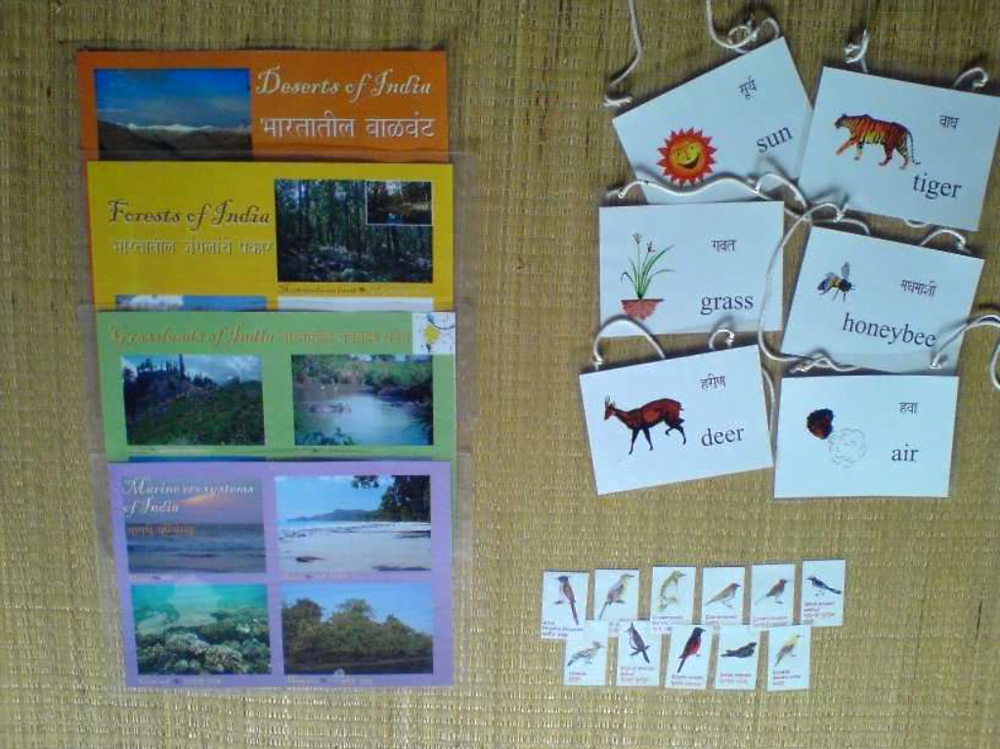
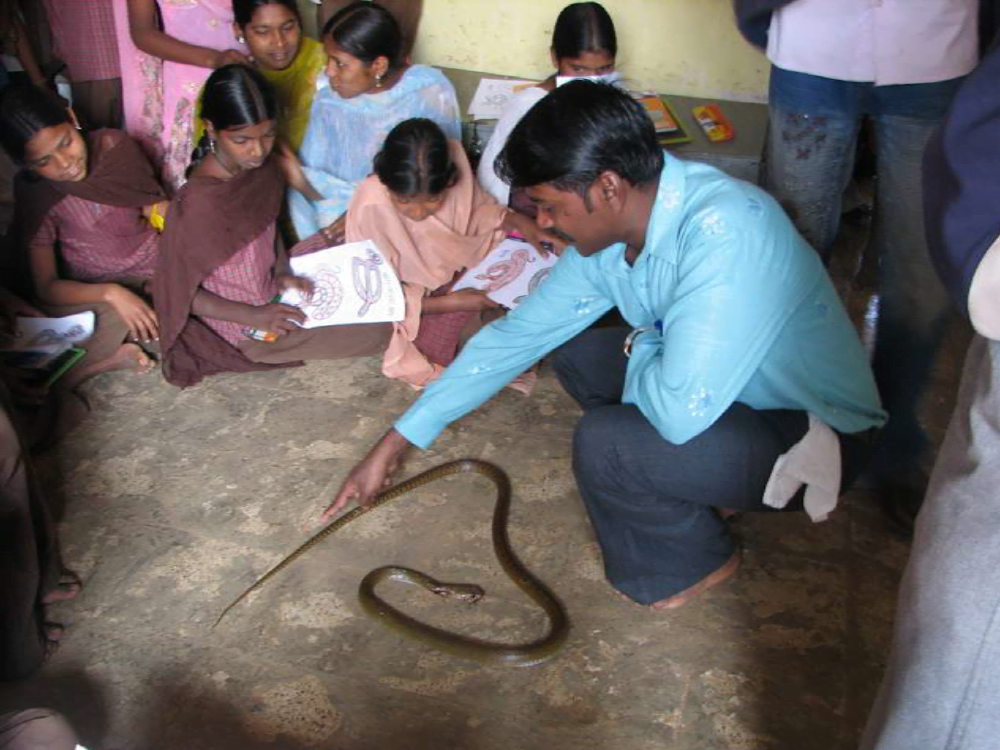

Bhimashanakar Wildlife Sanctuary, a Protected Area (PA), has a rich biodiversity. Local intervention and workshops were conducted by Kalpavriksh to create awareness and sensitise children of their rich environment. The programme was financially supported by Concern India, Ruffords Small Grants Fund and individual donations.
Bhimashankar Wildlife Sanctuary is located in the Ambegaon and Khed talukas of Pune district in Maharashtra. This evergreen forest in the Sahyadri mountain range was given protection by the State in 1984, mainly for the conservation of the Indian Giant Squirrel and its unique habitat. The area of the sanctuary extends over 130 sq km, which includes nine tribal villages. The area has been preserved as a cluster of sacred groves for generations, and hence, has been able to retain its immense bio-diversity.
The famous Shri Kshetra Bhimashankar temple, considered sacred and one of the twelve Jyotirlingas, is situated in the midst of the sanctuary. The area is frequented by lakhs of devotees and tourists every year. Bhimashankar is also the source of one of the major rivers of south India, Bhima, which is a tributary to the river Krishna.
The communities living within the sanctuary mainly belong to the Mahadeo Koli tribe.
Bhimashankar is a region witnessing rapid changes due to various internal and external influences. It has been observed that traditional knowledge, that was passed down from one generation to another is on the decline, and preservation of this knowledge is essential in order to understand forests and to conserve them.
The children of the local communities are most affected by the rapid social, economic and cultural changes in the area. The current education system has not been able to address the complex situation that these children are in, living in the forest areas but faced with new aspirations. Local contexts are not part of school curricula. Considering that these children are the future custodians of Bhimashankar, it is important to enable them to understand their rich natural and cultural heritage.
In the above context a strong need was felt for a site-specific education programme for the school children and teachers, and Kalpavriksh was approached by the Forest Department to carry out a sustained intervention in the schools.
The environment education programme was implemented at the Terungun and Tokawade Ashram schools in Bhimashankar area through workshops conducted by Kalpavriksh members and other resource persons who were identified through Maharashtra Arogya Mandal (MAM).
The knowledge base of the children and educators on issues pertaining to the conservation of Bhimashankar Sanctuary and its biodiversity was strengthened through activities at primary and upper school levels. Appropriate educational aids were developed. The activities were child-centric, and included games, art and craft and theatre. As far as possible, curricular links were drawn. Children were encouraged to gain traditional knowledge from their elders by facilitating interactions between these two groups.
Local youth were trained as environment educators, to ensure continuity the programme beyond the project phase. The training sessions were conducted in Pune as well as in Bhimashankar.
 A teacher’s handbook in Marathi was developed, titled Sahyadri – Nisargacha Anmol Theva. This book offers information on various aspects like ecosystems, biodiversity, threats and conservation measures with specific focus on the Sahyadri region in Maharashtra.
A teacher’s handbook in Marathi was developed, titled Sahyadri – Nisargacha Anmol Theva. This book offers information on various aspects like ecosystems, biodiversity, threats and conservation measures with specific focus on the Sahyadri region in Maharashtra.
Various educational aids such as posters, cards, booklets, games etc. in Marathi were developed for students to be used during workshops.
The material produced covered the following aspects:
- Geography and Biodiversity: Topography, water sources, forest types, flora and fauna
- Cultural importance: History, Pilgrimage site, Jyotirlinga, Religion and Nature conservation
- Protected Area status: Bhimashankar as a Wildlife Sanctuary, impacts due to declaration, management of the sanctuary
- Social aspects: Indigenous tribes, livelihood activities (agriculture, tourism, NTFP, medicinal plants etc) with relation with forests
- Threats and conservation: Identify threats and plan initiatives to support conservation
Sharmila Deo (Co-ordinator), Sujatha Padmanabhan (Project Advisor), Neema Pathak Broome and Pradeep Chavan from Kalpavriksh; Purnima Phadke, Pune; Chandrakant Langhi, Bhimashankar



The Snow Leopard Conservation Education Programme was a collaborative effort between the Snow Leopard Conservancy – India Trust (SLC-IT) and Kalpavriksh (KV) to facilitate the development and implementation of an environment education programme in Ladakh, focused on the conservation of Snow leopards and other wildlife of the local trans-Himalayan region.
While the SLC-IT was working with local agro-pastoralist communities in villages of Leh district (including the Hemis National Park) and in villages of the Zanskar region in Kargil district, a need was felt for more focused efforts to raise awareness amongst children about the environment with specific focus on Ladakh’s biodiversity and the conservation of Snow leopards.
The Ladakh region is part of the Trans-Himalayan region, and is a cold desert characterized by severe winters lasting over six months, with temperatures dropping as low as -50°C in some places. Ladakh has 310 species of birds (including 30 species not seen since 1960); 33 species of larger mammals (little information available on smaller mammals); 3 species of amphibians; 11 species of reptiles and about 611 species of flowering plants.
Much of Ladakh’s wildlife remained intact over centuries, probably because Buddhist teachings encouraged people to live peacefully with wildlife. However, a lot has changed in Ladakh over the last half century, and some fauna species like the wild yak, Tibetan gazelle and the Tibetan antelope have become endangered. Other species like the Snow leopard and the Tibetan wolf are also threatened due to people-wildlife conflicts.
The Snow leopard and the Tibetan wolf are sometimes the target of local people’s ire, as the two predators prey on domestic livestock. Although the wolf actually kills more domestic animals than the Snow leopard, it is the latter that has earned the anger of the local people. This maybe because while the wolf largely preys only on small livestock (like sheep and goats), the Snow leopard kills even large-bodied ones like horses and yaks. Losing these animals is a big economic loss for a rural family. Retaliatory killings of the Snow leopard and wolf do happen when local communities suffer livestock losses to these predators.
The reasons for the attacks are many: poorly constructed livestock enclosures that enable predators to gain entry; lax guarding practices; less number of herders available given the fact that many adults are absent from their villages due to job opportunities available with the army, government and in tourism; and increase in domestic livestock owned by local people.
SLC-IT invited Kalpavriksh personnel to help develop and implement an environment education programme that targets school children of upper primary and middle school levels. The programme was conceptualised in 2005, and work on the programme started in December 2005. Funding for the programme was received from SLC-USA and AID-Columbus and Portland. A total of 4.75 lakh rupees was received for the first year of work; and a total of 11.84 lakh rupees for the following two years.
Objectives of the programme
- To instil in children the knowledge and appreciation of their rich natural biodiversity.
- To encourage children to understand the importance of harmonious co-existence between humans and wildlife.
- To help children understand issues of wildlife conservation in the hope that they become future stewards of their natural environment.
Area of Operations
The programme has been implemented in 17 schools in Leh and Kargil districts since 2006. The schools were a diverse mix of government and private schools; primary, middle and high schools; those that were accessible by road and those that were not. The programme has so far reached out to over 600 children. In 2010 it was started in 7 schools.
Content and Design
The programme focused mainly on Ladakh’s wild biodiversity (flora and fauna), threats that it faces and conservation actions taken to tackle them. Concepts related to species and ecosystem levels of biodiversity were explored with Ladakh based examples. The content for the programme was put together from many sources: articles, research studies, interviews with local persons, information gathered from local NGOs, etc. The programme was aimed at children of grades 4 to 8. It was implemented by local persons who had an aptitude for such work.
The first year of the programme was aimed at increasing children’s knowledge about their local biodiversity. The programme was conducted through a series of special workshops at the schools. The second year of the programme saw the children working on local issues while still learning more about threats and conservation actions.
Tools Used
Many tools were used during the interactions with the children: discussion, role-play, worksheets, outdoor and indoor games, creative writing, nature study, art and craft, bird-watching trips, films, etc.
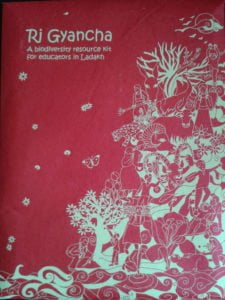 Kalpavriksh developed educational material to support the programme. This included “Ri Gyancha: a biodiversity resource kit for educators in Ladakh”. This resource kit provides a locale-specific environment education programme for those interested in Ladakh, especially its wildlife.
Kalpavriksh developed educational material to support the programme. This included “Ri Gyancha: a biodiversity resource kit for educators in Ladakh”. This resource kit provides a locale-specific environment education programme for those interested in Ladakh, especially its wildlife.
The resource kit includes a handbook with information on Ladakh’s wild biodiversity. The chapters are accompanied by activities to be conducted as part of the programme. Attractive teaching aids are part of the resource kit and include ready-to-use material like posters, nature cards, a board game and worksheets. The kit is available in our store.
After conducting five workshops, the children choose a local issue to work on. After an initial brainstorming exercise which lists all environmental issues in the village, the children vote to choose what they would work on. So far, schools have initiated garbage management projects in their villages, constructing bins or pits for collection of garbage in their villages and schools. Whitewashing of chortens (stupas) and plantations in schools have also been undertaken.
The projects are initiated with the involvement of family, community as well as Village Education Committee (VECs) members. A special function is held in each village with the help of the VEC, where the children share what they have learnt in this programme. Children also conduct some of the activities and games that were used in the programme; quiz, fauna bingo and web of life.
Team from Leh: Tsering Angmo (Education Coordinator), Rigzin Chondol, Rinchen Angmo, Kunzang Chotak Namgyal from Snow Leopard Conservancy-India Trust, Leh
Team from Pune: Sujatha Padmanabhan (Coordinator), Yashodara Kundaji, Sharmila Deo from Kalpavriksh Pune
For more information contact Sujatha Padmanabhan at [email protected]
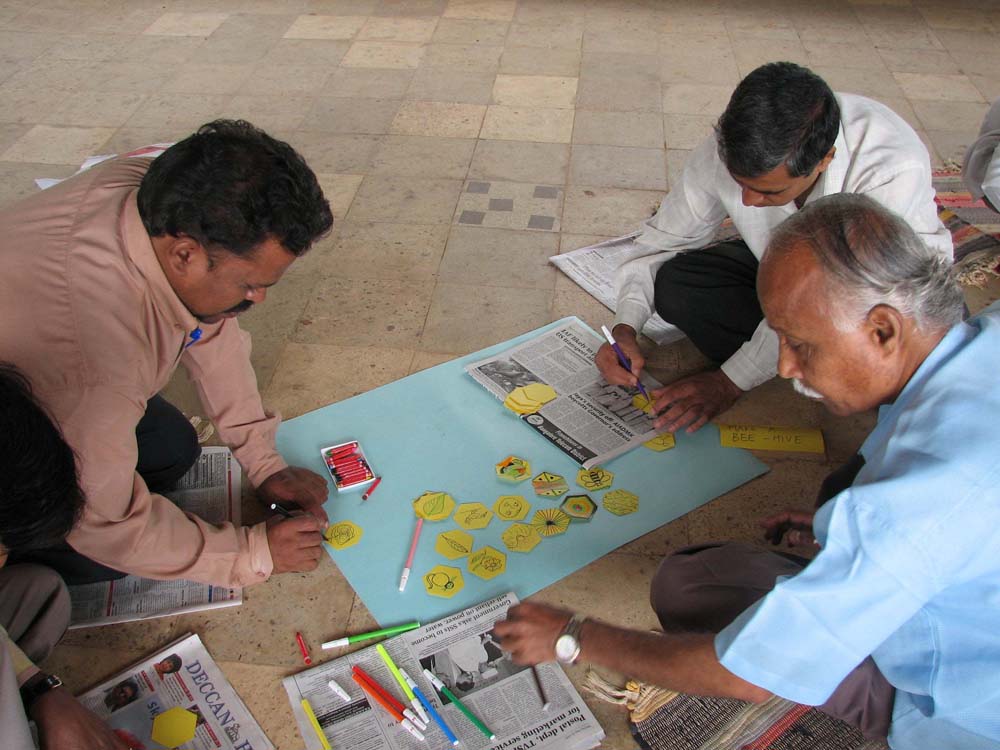
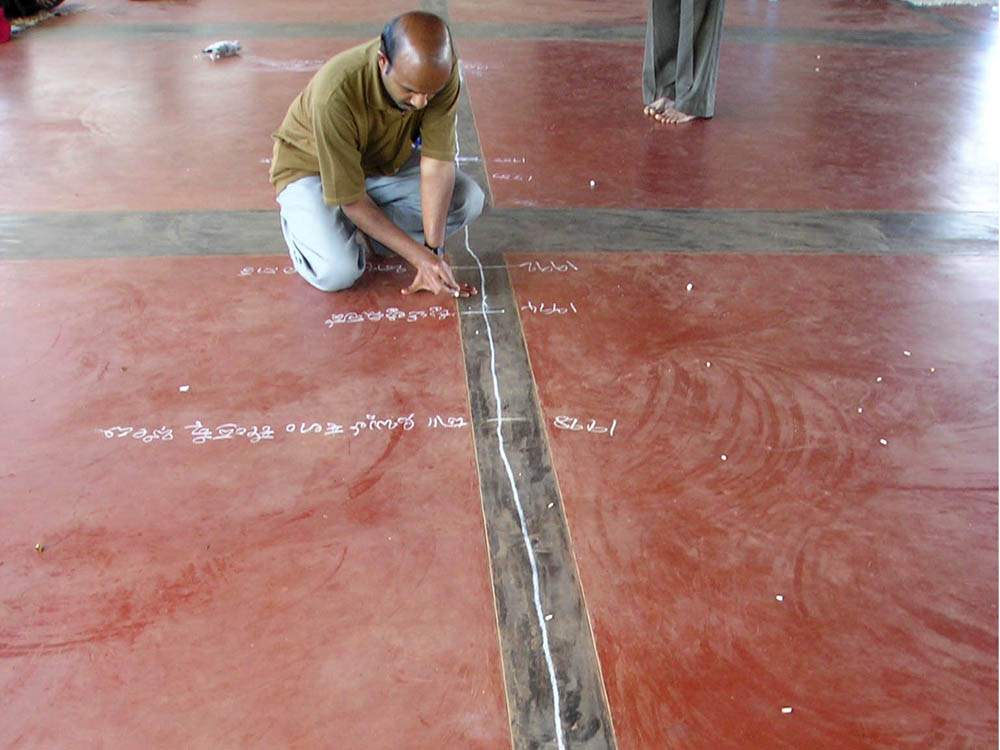
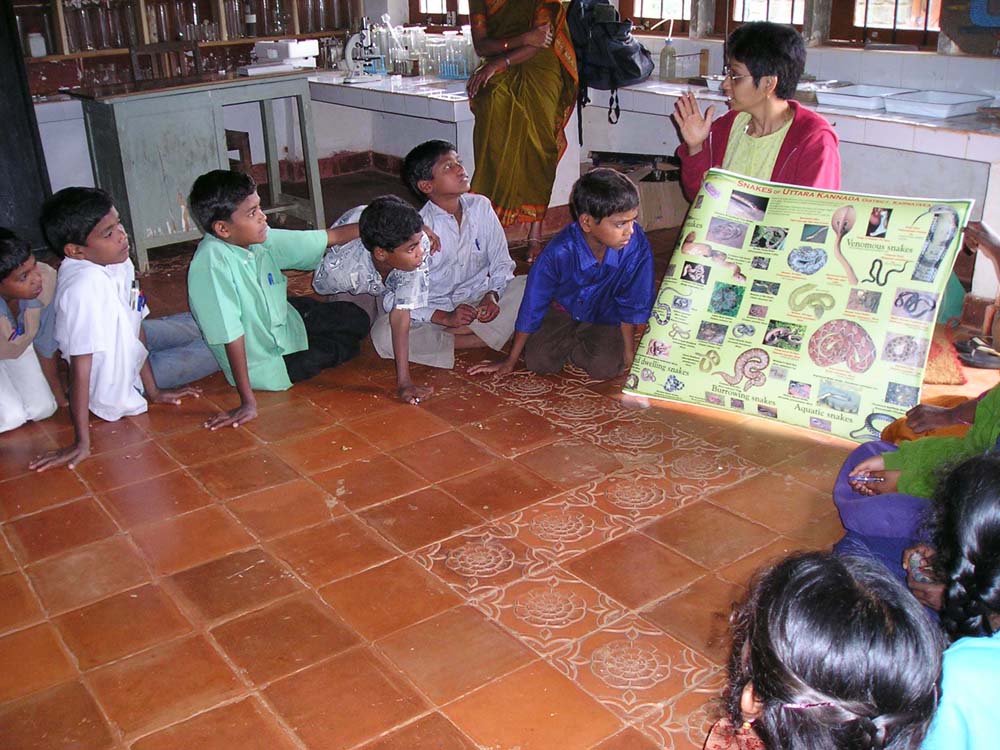
The “Learning for life – Nature as our teacher” programme was started in January 2004 in the Vivekananda Girijana Kalyana Kendra (VGKK) School. The programme was a collaborative effort between Ashoka Trust for Ecology and the Environment (ATREE), VGKK, and Kalpavriksh. The objective of the program was to develop a relevant conservation education programme for lower and upper primary and high school levels to be implemented in the VGKK school.
The VGKK School is situated in a unique context, in a small revenue pocket within the Biligiri Rangaswamy Temple (BRT) Wildlife Sanctuary. The Biligiri Rangaswamy (BR) Hills lie at a juncture that links the ecologically fragile Western and Eastern Ghats. A small population of the Soliga tribe lives within the sanctuary in hamlets, having had to give up their shifting cultivation practices and settle down after the area was declared a sanctuary in 1974. Many of the children who attend the VGKK residential school come from these settlements.
The need for developing this programme was felt by the teachers and administration of the school. Some of the reasons were:
- Erosion of traditional knowledge amongst the Soliga children over the years,
- A need to foster a scientific outlook amongst the students, and to make them aware of the rapid changes taking place in the outside world.
- Almost all the teachers are non-Soliga, and they expressed the desire to be oriented to the tribal way of life and to the issues of the sanctuary.
During the course of the programme, teachers, students, the local Soliga community, staff and researchers from VGKK and ATREE, and others gave information and guidance regularly. Research papers and literature on the BR Hills and the Soliga community were referred to. Draft chapters were shared with all concerned and the comments incorporated. Workshops were held with the teachers to field-test some activities.
A series of workshops to orient the teachers of the VGKK school to the use of the Handbook were planned. These workshops and the translation of the kit was supported by a grant from Asha for Education (Bangalore chapter). The first workshop was held in December 05.
As part of the programme, “Forests Alive!” a Handbook for teachers was developed, which explores a range of issues that are relevant to the lives of the Soligas within the BRT wildlife sanctuary. It also has a number of activities that the teachers could use to help children become more aware, sensitive, and proud of their culture and natural heritage. The content of the Handbook was discussed in a workshop with the teachers of the school, where decisions were also taken as to what topics would be dealt with at each level.
The entire package can be used as part of an EE programme for students from Classes 1 to 10. It can be adapted for non-formal learning programmes as well. The book can also be of interest to the Forest Department, wildlife tourists, NGOs and concerned individuals. While the Handbook is set in the BR Hills and BRT Wildlife Sanctuary context, its contents and activities can be adapted and used elsewhere in the country and outside.
Kannada version
The English version of Forests Alive! has been published in Kannada by Navkarnataka Publishers as Vana Sanjeevana. The Translation was done by Shri Nagesh Hegde, a reputed writer and journalist.
Sujatha Padmanabhan, Sunita Rao, Yashodhara Kundaji
For any additional information please do write to Sujatha Padmanabhan at [email protected]

